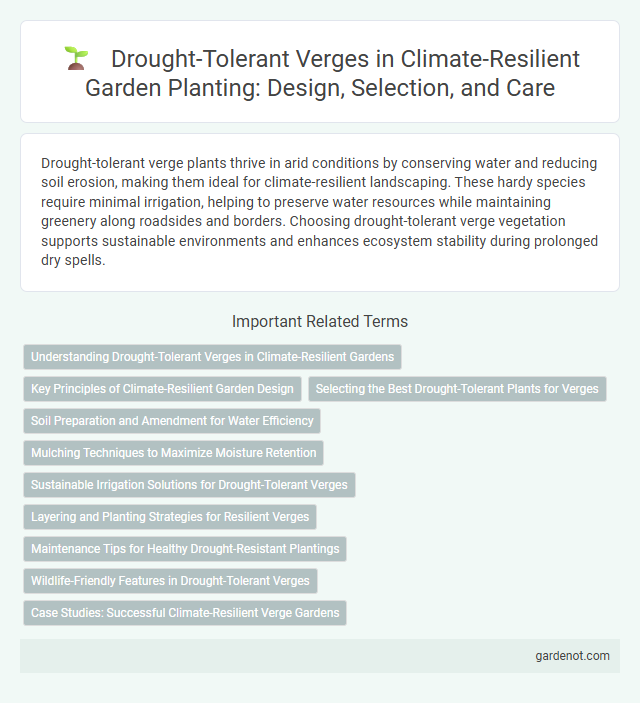Drought-tolerant verge plants thrive in arid conditions by conserving water and reducing soil erosion, making them ideal for climate-resilient landscaping. These hardy species require minimal irrigation, helping to preserve water resources while maintaining greenery along roadsides and borders. Choosing drought-tolerant verge vegetation supports sustainable environments and enhances ecosystem stability during prolonged dry spells.
Understanding Drought-Tolerant Verges in Climate-Resilient Gardens
Drought-tolerant verges are strategically designed planting strips that use native and resilient species to minimize water consumption while maintaining soil stability and providing habitat for pollinators. Implementing drought-resistant grasses, succulents, and deep-rooting perennials in verges reduces irrigation needs and improves the garden's overall climate resilience. These verges enhance urban landscapes by mitigating heat islands and supporting biodiversity under prolonged dry conditions.
Key Principles of Climate-Resilient Garden Design
Drought-tolerant verge planting incorporates native, deep-rooted species that improve soil moisture retention and reduce water demand, aligning with climate-resilient garden design principles. Utilizing permeable soil amendments and mulches enhances water infiltration and minimizes evaporation, crucial for sustaining plant health during prolonged dry spells. Strategic plant selection and placement create microclimates that promote resilience by maximizing shade and reducing surface heat, key factors in mitigating drought stress.
Selecting the Best Drought-Tolerant Plants for Verges
Selecting drought-tolerant plants for verges involves choosing species with deep root systems and high water-use efficiency, such as lavender, sedum, and native grasses like buffalo grass. These plants reduce maintenance needs and conserve water while maintaining greenery during prolonged dry periods. Incorporating native, drought-resistant species supports local biodiversity and soil health, enhancing the verge's climate resilience.
Soil Preparation and Amendment for Water Efficiency
Drought-tolerant verge planting requires thorough soil preparation and amendment to maximize water efficiency and retention. Incorporating organic matter such as compost or biochar improves soil structure, enhances moisture-holding capacity, and supports beneficial microbial activity. Amending soil with materials like gypsum or sand increases permeability, reduces runoff, and promotes deep root penetration essential for sustaining plants in arid conditions.
Mulching Techniques to Maximize Moisture Retention
Mulching techniques play a crucial role in drought-tolerant verge planting by significantly enhancing soil moisture retention. Organic mulches such as wood chips, straw, or compost create a protective barrier that reduces evaporation, insulates soil temperatures, and suppresses weed growth. These methods maintain consistent moisture levels, improve soil structure, and support plant health in arid conditions, promoting sustainable and climate-resilient landscapes.
Sustainable Irrigation Solutions for Drought-Tolerant Verges
Drought-tolerant verges incorporate native, low-water-use plants that minimize irrigation needs, enhancing climate resilience in urban landscapes. Precision drip irrigation systems and rainwater harvesting techniques optimize water use efficiency, reducing runoff and conserving resources. Employing soil moisture sensors allows for targeted watering schedules, ensuring sustainable management of drought-tolerant verge ecosystems.
Layering and Planting Strategies for Resilient Verges
Drought-tolerant verge design incorporates layered planting strategies that combine deep-rooted shrubs, native grasses, and groundcovers to enhance soil moisture retention and reduce evaporation. Utilizing multi-tiered vegetation not only stabilizes the soil but also improves ecosystem resilience by supporting biodiversity and minimizing water dependency. Strategic species selection with varying root depths fosters efficient water uptake and sustains verge health during prolonged dry periods.
Maintenance Tips for Healthy Drought-Resistant Plantings
Maintaining a healthy drought-tolerant verge requires consistent monitoring of soil moisture levels and pruning dead or damaged foliage to promote vigorous growth. Applying mulch around plants helps retain soil moisture and reduces evaporation, while deep, infrequent watering encourages strong root development. Selecting native or well-adapted drought-resistant species minimizes irrigation needs and enhances long-term resilience against dry conditions.
Wildlife-Friendly Features in Drought-Tolerant Verges
Drought-tolerant verges incorporate native grasses and succulents that require minimal water while providing essential habitats for pollinators and small wildlife, enhancing urban biodiversity. These verges support bird species by offering seeds and shelter, and promote soil health through deep-rooted plants that reduce erosion and improve water retention. Implementing wildlife-friendly features in drought-tolerant verges contributes to ecological resilience and helps maintain stable ecosystems amid increasing drought conditions.
Case Studies: Successful Climate-Resilient Verge Gardens
Climate-resilient verge gardens featuring drought-tolerant plants have demonstrated remarkable success in urban environments by significantly reducing water consumption while maintaining aesthetic appeal. Case studies from regions such as California and Australia reveal that native species like California poppy and kangaroo paw not only survive prolonged dry periods but also support local biodiversity. These projects showcase effective strategies for sustainable verge management that enhance community resilience against climate change impacts.
Drought-tolerant verge Infographic

 gardenot.com
gardenot.com